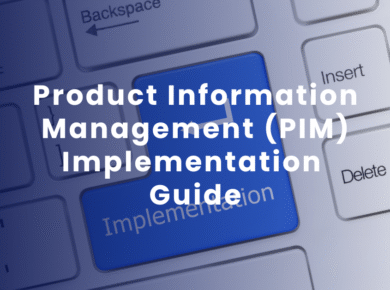How Will GenAI Redefine the Hybrid Shopper Experience? Read Blog Holiday shopping
Why Accurate Product Information Drives Business Success?
In today’s digital-first economy, competitive advantage often comes down to one factor: how effectively businesses manage and distribute their product information. Product Data Syndication (PDS) has become a cornerstone of modern commerce, ensuring accurate, consistent, and timely product details reach customers across every channel. When paired with a strong Product Information Management (PIM) system, PDS not only reduces inefficiencies but also accelerates growth and builds stronger market presence.
According to Gartner, poor data quality costs organizations an average of $12.9 million annually. Forrester reports that companies that invest in PIM and syndication strategies achieve 20% higher online sales and fewer product returns. These numbers prove that reliable product data directly impacts growth and profitability.
What Is Product Data Syndication?
Product Data Syndication (PDS) is the process of sharing detailed product information, such as descriptions, specifications, images, and prices, across multiple sales channels, including eCommerce sites, distributors, and retail partners.
It ensures that each channel receives the right content in the right format, helping brands create a consistent customer experience while increasing visibility.
Why Product Data Syndication Matters for Businesses?
- Reach More Customers: Expand visibility across global and local platforms.
- Work Smarter, Not Harder: Automation reduces errors, delays, and manual effort.
- Build Partner Trust: Consistent, accurate data strengthens retailer and distributor relationships.
- Launch Products Faster: Streamlined syndication speeds up go-to-market timelines.
- Improve Customer Experience: Clear, tailored information boosts engagement and loyalty.
Best Practices for Effective Product Data Syndication
- Select the Right Partners
- Make sure their systems integrate with your PIM platform.
- Check if they can customize content for different platforms.
- Look for proven performance and strong customer support.
- Check Data Before Sharing
Always validate data for accuracy and consistency. PIM systems help reduce risks of errors or outdated details.
- Use Standard Formats
Common formats like CSV, XLS, JSON, or XML keep information easy to share and reduce mistakes.
- Customize for Each Channel
Adapt content to platform-specific requirements to increase engagement.
- Track and Improve
Measure accuracy, update frequency, and partner performance to refine your approach.
- Review Partnerships Regularly
Reassess syndication partners to ensure they still align with your growth goals.
What is PIM?
Before diving into its role in syndication, it’s important to understand what a Product Information Management (PIM) system actually is. A PIM is a centralized platform that stores, manages, and enriches all product-related information from technical specifications and pricing to digital assets like images and videos. Acting as the single source of truth, it ensures consistency across every channel and team. Businesses often rely on PIM solutions to simplify data governance, improve collaboration, and support seamless digital commerce. Read more.
How PIM Supports Syndication?
- One Central Hub: All product information stored in one place.
- Error-Free Distribution: Automation reduces manual work and inconsistencies.
- Better Teamwork: Internal teams and external partners can work with the same trusted data.
- Ready to Scale: Easily add new markets and channels without major process changes.
Turning Product Data Syndication Into a Growth Strategy
Product Data Syndication (PDS) has moved beyond its original role as a support process. In the current digital commerce environment, it functions as a core enabler of growth. Organizations that implement structured syndication supported by Product Information Management (PIM) systems achieve measurable improvements in speed, accuracy, and scalability.
Key business outcomes include:
- Market Expansion: Syndicated product data enables faster entry into new marketplaces, geographies, and retail ecosystems without duplication of effort.
- Stronger Partner Ecosystems: Retailers and distributors prioritize suppliers who deliver reliable, consistent, and updated product information, strengthening long-term business relationships.
- Customer Experience at Scale: Standardized, accurate, and channel-specific product data reduces confusion, ensures compliance, and supports higher conversion rates across digital and physical channels.
- Operational Agility: Automated syndication combined with centralized management shortens the response time for pricing updates, product launches, and regulatory requirements.
PDS, when executed with the right PIM framework, is not an operational afterthought, but a structured growth strategy. Organizations that prioritize accuracy, automation, and scalability in syndication are better positioned to meet evolving market demands and secure sustainable business advantage.
Ready to unlock growth with accurate and scalable product data syndication? Request a custom demo today and see how our PIM-driven approach can transform your digital commerce strategy.
Latest Resources
How Unified Data Can Keep You Ahead This Holiday Read Blog As
Enterprise Data Management in Transition: 2026 Trends and AI-Driven Shifts Read Blog
Unlocking Growth: Why PIM DAM Integration Is a Strategic Imperative Read Blog
Mastering Product Data Syndication: A Business-Centric Approach Read Blog Why Accurate Product
The Hidden Costs of Missing Metadata in Digital Asset Management Read Blog
Key Takeaways: Identify the Right Time for PIM: Gain clarity on identifying
PIM vs MDM: What’s the Difference and When to Use Each? Read
Questions to Ask When Choosing a PIM Vendor? - Part 2 Read
Questions to Ask When Choosing a PIM Vendor? - Part 1 Read









